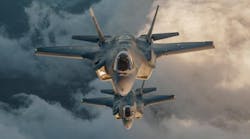Lockheed Sees 2018 Profit Gain on Tax Cut, F-35 Fighter Jet
Lockheed Martin Corp. expects profit to surge this year, even if sales don’t, as the company benefits from U.S. tax cuts and higher deliveries of its F-35 Lightning II fighter jet.
Earnings will more than double to as much as $15.50 a share, the world’s largest defense contractor said on Jan. 29. Analysts, who hadn’t yet factored in the tax impact and an accounting change, predicted $14.13 a share, according to estimates compiled by Bloomberg.
Lower federal levies are providing a timely boost for Lockheed as the company encounters a waning demand for some of its oldest aircraft and ramps up output of the F-35, its most advanced jet. The weapons maker is also poised to benefit as President Donald Trump readies a proposal for a sharp increase in defense spending next year.
“That’s a positive backdrop for Lockheed and its peers,” said Douglas Rothacker, an analyst at Bloomberg Intelligence.
2018 Outlook
Lockheed expects revenue to increase less than 1% to a range of $50 billion to $51.5 billion. Executives had warned in October that growth would taper in 2018 as the company seeks to jumpstart F-16 fighter sales and starts to move the F-35 fighter into higher gear.
Cash from operations is also expected to dip this year as Lockheed pours $5 billion into its defined benefit plans. Prepaying pension obligations through 2021 should provide about a $1 billion benefit under an accounting standard that enables U.S. defense contractors to recapture some of their pension expense.
The Bethesda, Md.-based company expects to generate about $3 billion in cash from operations this year, followed by $7 billion cash bounties in 2019 and 2020, according to presentation slides posted on its website.
Accounting Charge
The new, lower tax rate also clipped fourth-quarter results, at least on paper. Lockheed reported a $1.9 billion one-time charge related to a reduction in its deferred tax assets, an accounting feature that allows a company to use past losses to offset taxable income in the future. Most of the writedown was noncash.
Investors looked past a $715 million net loss from continuing operations to the performance of Lockheed’s underlying business, as well as the bulge of cash it promises to return to shareholders through dividends and stock buybacks.
Lockheed is typically the first U.S. defense company to report earnings, setting investor expectations for other prime contractors. This quarter it waited as Northrop Grumman Corp. and Raytheon Co. walked analysts through the pros and cons of the complicated tax revisions.
Excluding the writedown, adjusted fourth-quarter profit rose to $4.30 a share, compared with the $4.06 average of analyst estimates, as Lockheed benefited from higher production volume of its F-35 fighter. Revenue climbed 10% to $15.1 billion. Analysts had estimated $14.7 billion.
During the fourth quarter, the company delivered 22 of its F-35, six more fighters than a year earlier. Net sales of the advanced fighter, the Pentagon’s most expensive weapons system, grew $570 million from a year earlier.
Lockheed only delivered one F-16 in the fourth quarter after earlier ending production of the fighter in its factory in Fort Worth, Texas, to free space for making more F-35s. The company met its goal of delivering 66 of the advanced fighters in 2017 and plans to bolster annual output to about 160 jets by the mid-2020s, Rothacker said
By Julie Johnsson




